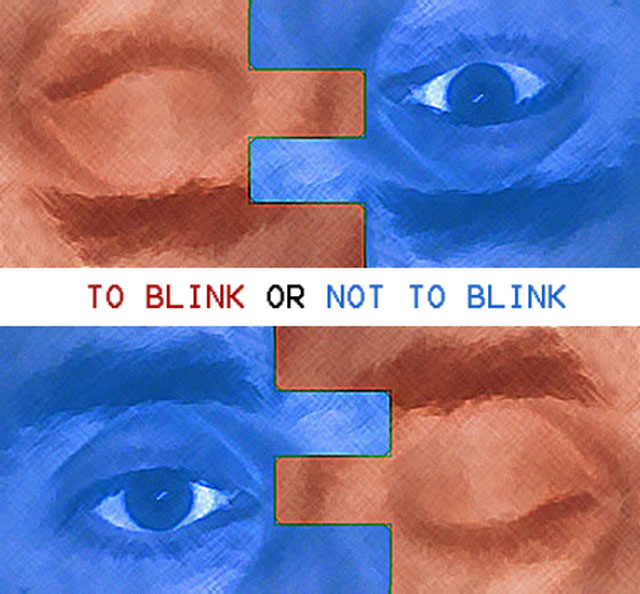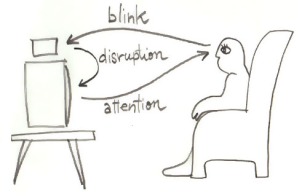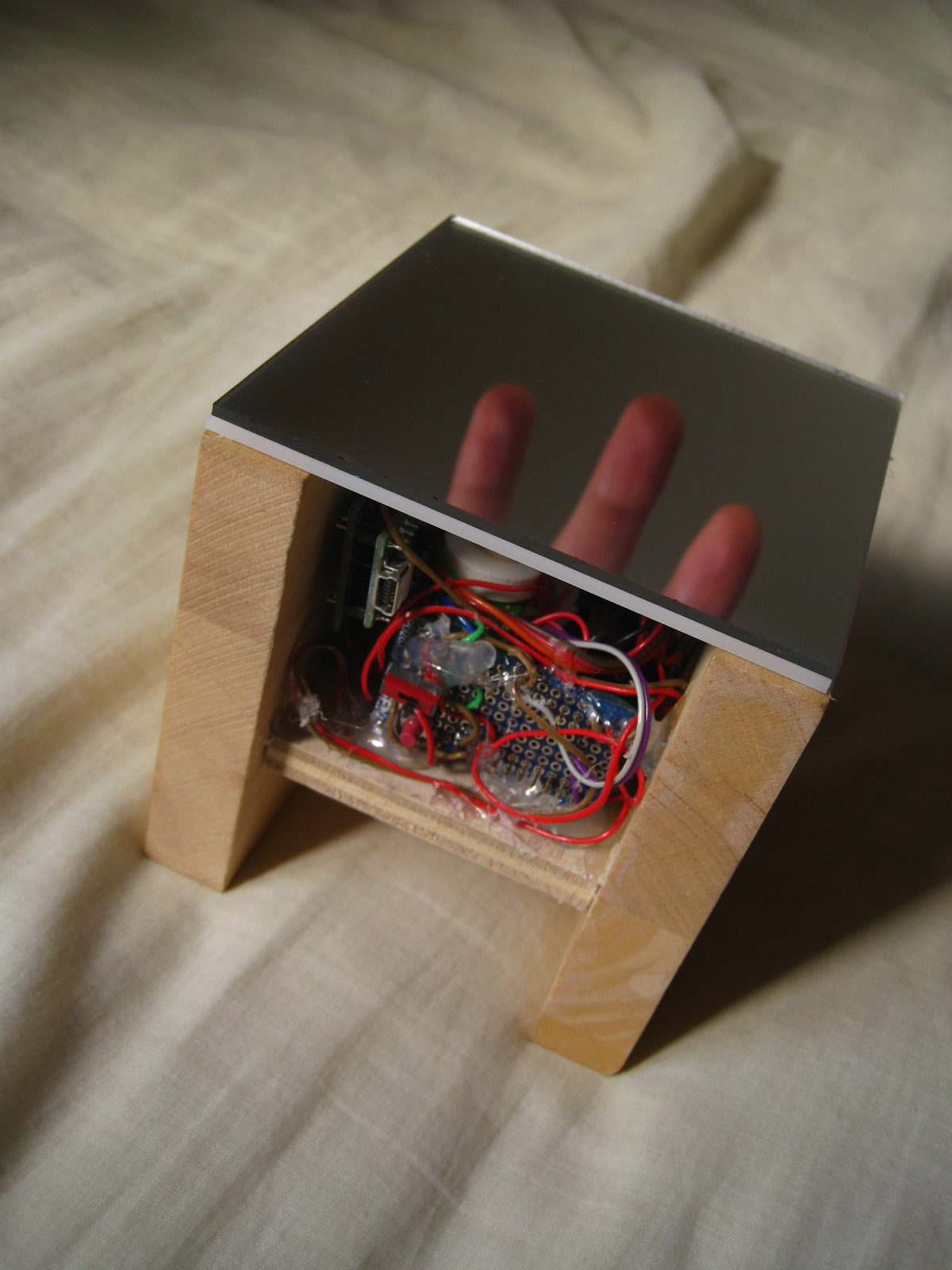Álvaro Cassinelli & Stéphane Perrin – 2008. Many thanks to Jacqueline Steck for sharing initial code for blink detection.
Artist statement
To blink or not to blink is a reflection on the active role that the (supposedly) passive spectator plays in post-editing and censoring visual media. To give an example: it may take a whole day to generate five seconds of a stop motion movie; this means that blinking for a fraction of a second equates to skipping several hours of hard work. Were the creators of the movie conscious of the possibility of this disrespectful intervention in the first place? Most likely not, but unless one straps the spectator to a chair, with his eyes artificially held open as Alex’s in A Clockwork Orange, blinking will be inescapable: it’s a natural feature of the act of seeing with human eyes.
The installation
A darkened corner reproduces the looks of a small, gloomy apartment. A sofa placed right in this corner faces a TV set. The remote is visibly placed on a small table that sits between the sofa and the TV set. This setup invites the spectator to sit on the sofa and switch on the TV. Not noticing anything peculiar with the TV, he may browse some local programs before he briefly pauses on something more or less interesting. However, after less than ten seconds of watching, the emission will interrupt and the TV will switch randomly to another program. The spectator may switch back to the favorite program using the remote, but this would have created a gap in the program. If he does not uses the remote, the new program will eventually also be interrupted in a seemingly random way. In fact, it will take two or three of these interruptions for the spectator to discover that he is causing these disruptions by just blinking the eyes.
Perhaps blinking is not the meanest form of disrespect that our body can show towards the filmmaker’s hard work (going to the toilets in the middle of a movie is certainly worse), but it’s symbolically much more powerful: blinking introduces random cuts in a carefully edited film.To blink or not to blink seeks to amplify the consequences of blinking, and make them clear to the spectator himself. The idea is that the spectator will pay these moments of fleeting disinterest by losing track of whatever he was seeing. The spectator, now aware of this trade will be left facing a dilemma: if he is truly interested on what he is seeing, he will force himself to maintain the eyes wide open as long as he can (which is the only way to avoid disruptions producing significant gaps in the story).
However, the more attention he puts on the video, the less conscious he becomes of his natural body attitudes, and he may blink inadvertently. If, on the contrary, he succeeds in abstaining from blinking for a sufficiently long time, he will still create gaps in the story, this time attentional gaps because of the effort that this unnatural attitude suppose.After a while, the spectator is forced to conclude that his organic body plays a fundamental role in modulating the visual content, and that he, as an observer is neither innocent nor passive. After this experience, he may look at the world with different eyelids.
Installation Setup
The simplest (and preferred) setting requires a dimly lit corner in an open exhibition space (see image on the right). A sofa (for one person) is placed right in that corner, facing the TV set. A unique spectator experiences the installation at a time. The rest of the public cannot directly see the images projected on the TV, and so does not clearly understands the logic of the interaction. However, this public can still see the face of the spectator being illuminated by changing patterns of light, as well as hear the changing soundtracks of the TV (see video in the description page).
Since the installation is conceived to be experienced by one spectator at a time, a more intimate experience can be achieved by setting the installation in a dimly lit room with a single entrance. In that case, the atmosphere of the room can be specifically tuned to the projected video. For instance, four different videos can be used instead of local TV programs. Interaction would be slightly different: when the spectator enters the room, the screen is filled with snow; as he sits, the screen stabilizes and he will see what can be interpreted as the first images of an old movie he fails to recognize. The spectator’s curiosity focuses on these images and on the story behind them. However, after less than a minute he notices that the video interrupts randomly from time to time, in order to show another video track. Four videos are thus interleaved and the passage from one to the other is triggered by blinking.
Technical Statement
The technical heart of the installation is the blink detection mechanism. This is achieved by continuously shooting a close up of the spectator’s face. The camera (that can be located anywhere as long as it is able to capture the face of the spectator) is connected to a computer that processes the images in real time. After finding the face (using openCV Haar-classifier library, integrated in openFrameworks), the location of the eyes is inferred (face proportions). Finally, blink detection is performed by simple frame differencing in that region of interest*. Efficient and robust detection of the blink is possible even in dimly lit environment by using an infrared light source.


Each time a blink is detected, the information is send wirelessly (Bluetooth modem) to a microcontroller (an Arduino Mini). The microcontroller then activates a small servo-motor that press the channel button on the TV remote controller. We use a universal remote controller to “jam” the channels, so the installation can be easily prepared on any TV set. This remote is inserted below the “bluetooth zapping module” (see image on the right) and both the remote and the zapping module are hidden somewhere nearby (for instance, under the table). On the other hand, the original remote controller is left visible over the table, perfectly accessible to the spectator. Even though the zapping module is invisible, the spectator can hear the characteristic robotic sound produced by the servo-motor as it presses the buttons on the remote. Since this sound perfectly correlates with blinking, it gives the spectator a direct clue about what is happening. Additionally, it produces the gives the eerie feeling of being somehow part of the machine. The zapping module is a small box containing the servo-motor, a microcontroller and a bluetooth modem. It is battery powered (batteries last several days without recharging). The top of the box is a semi-reflective mirror that is illuminated from the inside each time a blink occurs.
- More info: http://toblinkornot.wordpress.com/
- A. Cassinelli and S. Perrin, To Blink or Not To Blink, Third Workshop on Devices that Alter Perception (DAP 2010) in conjunction with ISMAR 2010, October 13th, 2010, Seoul, South Korea [PDF-250KB]









